Buy 100 mg zudena overnight deliveryThe base o the emoral canal is the oval emoral ring ormed by the small (approximately 1-cm wide) proximal opening at its abdominal end low cost erectile dysfunction drugs buy cheap zudena 100 mg. This opening is closed by extraperitoneal atty tissue that orms the transversely oriented emoral septum impotence vs infertile buy zudena canada. The emoral septum is pierced by lymphatic vessels connecting the inguinal and exterior iliac lymph nodes impotence pump medicare cheap zudena online visa. The pulsations o the emoral artery are palpable within the emoral triangle as a outcome of o its comparatively supercial position deep (posterior) to the ascia lata impotence zoloft buy discount zudena 100mg line. The emoral artery lies and descends on the adjoining borders o the iliopsoas and pectineus muscles that orm the foor o the triangle. The supercial epigastric artery, supercial (and sometimes the deep) circumfex iliac arteries, and the supercial and deep exterior pudendal arteries come up rom the anterior facet o the proximal half o the emoral artery. The prounda emoris artery (deep artery o thigh) is the biggest branch o the emoral artery and the chie artery to the thigh. It arises rom the lateral or posterior facet o the emoral artery within the emoral triangle. The perorating arteries provide muscular tissues o all three ascial compartments (adductor magnus, hamstrings, and vastus lateralis). The circumex emoral arteries encircle the uppermost shat o the emur and anastomose with one another and different arteries, supplying the thigh muscles and the superior (proximal) end o the emur. The medial circumex emoral artery is very important because it provides most o the blood to the head and neck o the emur through its branches, the posterior retinacular arteries. The retinacular arteries are oten torn when the emoral neck is ractured or the hip joint is dislocated. The lateral circumex emoral artery, much less able to supply the emoral head and neck as it passes laterally across the thickest part o the joint capsule o the hip joint, primarily supplies muscle tissue on the lateral side o the thigh. The obturator artery helps the prounda emoris artery supply the adductor muscular tissues by way of anterior and posterior branches, which anastomose. The posterior branch provides o an acetabular branch that provides the head o the emur. The emoral vein is the continuation o the popliteal vein proximal to the adductor hiatus. As it ascends through the adductor canal, the emoral vein lies posterolateral after which posterior to the emoral artery. The emoral vein enters the emoral sheath lateral to the emoral canal and ends posterior to the inguinal ligament, where it turns into the exterior iliac vein. In the inerior half o the emoral triangle, the emoral vein receives the prounda emoris vein, the good saphenous vein, and different tributaries. The prounda emoris vein (deep vein o thigh), ormed by the union o three or our (continued on p. Ascending department provides anterior part o gluteal region; transverse department winds round emur; descending branch joins genicular peri-articular anastomosis. Anterior department provides obturator externus, pectineus, adductors o thigh, and gracilis; posterior department supplies muscular tissues connected to ischial tuberosity. Orientation drawing displaying the adductor canal and the extent o the part shown in B. This transverse section o the thigh shows the muscular tissues bounding the adductor canal and its neurovascular contents. Surace Anatomy o Anterior and Medial Regions o Thigh In airly muscular people, some o the cumbersome anterior thigh muscle tissue could be observed. The outstanding muscle tissue are the quadriceps and sartorius, whereas laterally, the tensor asciae latae is palpable as is the iliotibial tract to which this muscle attaches. The rectus emoris could also be simply observed as a ridge passing down the thigh when the lower limb is raised rom the foor whereas sitting. The patellar ligament is well noticed, particularly in skinny folks, as a thick band running rom the patella to the tibial tuberosity. You can also palpate the inrapatellar at pads, the lots o free atty tissue on all sides o the patellar ligament. On the medial side o the inerior part o the thigh, the gracilis and sartorius muscular tissues orm a well-marked prominence, which is separated by a melancholy rom the massive bulge ormed by the vastus medialis.
Syndromes - Fermented milk products, such as yogurt
- Avoid foods such as Brussels sprouts, turnips, cabbage, beans, and lentils
- Fast breathing
- Breathing problems
- Limb-kinetic apraxia: This condition involves difficulty making precise movements with an arm or leg. It becomes impossible to button a shirt or tie a shoe.
- Chemical irritation
- Persistent, unexplained darkening or lightening of the skin
- Vomiting
- Von Willebrand factor specific tests
- Bronchiectasis
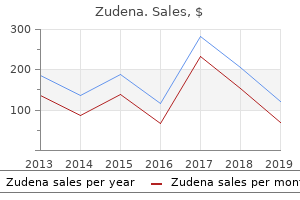
Purchase 100mg zudena fast deliveryThe parasympathetic root o the celiac plexus is a branch o the posterior vagal trunk erectile dysfunction groups in mi buy zudena amex, which contains bers rom the best and let vagus nerves erectile dysfunction vacuum pumps pros cons discount 100mg zudena amex. Vasomotion (control o blood fow) at this level infuences water and electrolyte motion erectile dysfunction treatment in qatar purchase cheap zudena. Corresponding plexuses with smaller best erectile dysfunction vacuum pump zudena 100 mg visa, sparser ganglia prolong to the pancreas, gallbladder, and cystic and major biliary ducts. Abdominal Viscera 531 the motor neurons o these plexuses are intrinsic or enteric ganglia that serve nominally as postsynaptic neurons or the parasympathetic system. In addition to unctioning as relay neurons, receiving and passing on eerent impulses sent by presynaptic parasympathetic neurons, in addition they receive enter rom postsynaptic sympathetic bers (making them a third-order neuron in that system). They have vast interconnectivity with surrounding eerent neurons, both directly and by way of interneurons, in addition to axons terminating on smooth muscle and glands. In addition, there are intrinsic aerent neurons with cell bodies within the plexuses that monitor mechanical and chemical situations within the intestine and communicate with the eerent neurons providing native (short) refex circuitry, in addition to sending inormation centrally. Schematic illustration o the organization o the enteric nervous system throughout the intestinal wall. Flow chart demonstrating long (extrinsic) and short (intrisic) reexes involving the enteric nervous system. With regard to the sleek muscle sphincters, the roles o the sympathetic and parasympathetic methods reverse, with the sympathetic system maintaining tonus and the parasympathetic system inhibiting it. Relatively nonpermeable capillaries associated with the ganglia present a diusion barrier resembling the blood�brain barrier o cerebral blood vessels. Approximate spinal twine segments and spinal sensory ganglia involved in sympathetic and visceral aerent (pain) innervation o abdominal viscera are shown. Visceral aerent bers conveying pain sensations accompany the sympathetic (visceral motor) bers. The ache impulses move retrogradely to these o the motor bers alongside the splanchnic nerves to the sympathetic trunk, through white speaking branches to the anterior rami o the spinal nerves. Then they pass into the posterior root to the spinal sensory ganglia and spinal cord. The stomach (oregut) receives innervation rom the T6 to T9 levels, small gut by way of transverse colon (midgut) rom the T8 to T12 ranges, and descending colon (hindgut) rom the T12 to L2 ranges. Starting rom the midpoint o the sigmoid colon, visceral pain bers run with parasympathetic bers, the sensory impulses being performed to S2�S4 sensory ganglia and spinal wire levels. These are the identical spinal twine segments involved in the sympathetic innervation o those portions o alimentary tract. The fbers traverse the paravertebral ganglia o the trunks with out synapsing, persevering with as elements o abdominopelvic splanchnic nerves. The sympathetic fbers move to prevertebral ganglia, most o which are clustered across the main branches o the abdominal aorta. Ater synapsing within the ganglia, the postsynaptic sympathetic fbers join the presynaptic parasympathetic fbers, touring by way of peri-arterial plexuses across the branches o the belly aorta to attain the viscera. A continuation o the abdominal aortic plexus inerior to the aortic biurcation (the superior and inerior hypogastric plexuses) conveys sympathetic innervation to most o the pelvic viscera. The sympathetic fbers primarily innervate the blood vessels o abdominal viscera and are inhibitory to the parasympathetic stimulation. The parasympathetic fbers synapse on or within the partitions o the viscera with intrinsic postsynaptic parasympathetic neurons, which terminate on the sleek muscle or glands o the viscera. Parasympathetic innervation: the vagus nerves supply parasympathetic fbers to the digestive tract rom the esophagus through the transverse colon. Parasympathetic stimulation promotes peristalsis and secretion (although much o the latter is normally hormonally regulated). Sensory innervation: Visceral aerent fbers ollow the autonomic fbers retrograde to sensory ganglia. Aerent fbers conveying pain sensation rom abdominal viscera orad (proximal) to the center o the sigmoid colon run with the sympathetic fbers to the thoracolumbar spinal sensory ganglia; all other visceral aerent fbers run with the parasympathetic fbers. Thus, visceral aerent fbers conveying reex inormation rom the intestine orad to the middle o the sigmoid colon cross to vagal sensory ganglia; fbers conveying both pain and reex inormation rom the intestine aborad (distal) to the middle o the sigmoid colon move to spinal sensory ganglia S2�S4.
Discount zudena 100 mg fast deliveryA similar however smoother and more distinguished ridge erectile dysfunction gluten buy generic zudena 100 mg line, the intertrochanteric crest common causes erectile dysfunction buy zudena cheap, joins the trochanters posteriorly erectile dysfunction treatment natural way buy zudena 100 mg fast delivery. This convexity may enhance markedly impotence nitric oxide buy zudena without prescription, proceeding laterally in addition to anteriorly, i the shat is weakened by a loss o calcium, as occurs in rickets (a illness attributable to vitamin D deciency). Most o the shat is smoothly rounded, providing feshy origin to extensors o the knee, besides posteriorly where a broad, rough line, the linea aspera, provides aponeurotic attachment or adductors o the thigh. This vertical ridge is very outstanding in the center third o the emoral shat, where it has medial and lateral lips (margins). Superiorly, the lateral lip blends with the broad, tough gluteal tuberosity, and the medial lip continues as a slim, tough spiral line. A distinguished intermediate ridge, the pectineal line, extends rom the central part o the linea aspera to the bottom o the lesser trochanter. Ineriorly, the linea aspera divides into medial and lateral supracondylar strains, which lead to the medial and lateral emoral condyles. The medial and lateral emoral condyles make up practically the whole inerior (distal) end o the emur. The two condyles are on the identical horizontal degree when the bone is in the anatomical place, so that i an isolated emur is positioned upright with both condyles contacting the foor or tabletop, the emoral shat will assume the identical oblique place it occupies within the living physique (about 9� rom vertical in males and slightly higher in emales). The emoral condyles articulate with menisci (crescentic plates o cartilage) and tibial condyles to orm the knee joint. The menisci and tibial condyles glide as a unit across the inerior and posterior features o the emoral condyles during fexion and extension. The convexity o the articular surace o the condyles will increase as it descends the anterior surace, masking the inerior finish, after which ascends posteriorly. The condyles are separated posteriorly and ineriorly by an intercondylar ossa however merge anteriorly, orming a shallow longitudinal depression, the patellar surace. The lateral surace o the lateral condyle has a central projection called the lateral epicondyle. The medial surace o the medial condyle has a larger and extra distinguished medial epicondyle, superior to which another elevation, the adductor tubercle, orms in relation to a tendon attachment. The epicondyles present proximal attachment or the medial and lateral collateral ligaments o the knee joint. The anterior third o the crests is well palpated because the crests are subcutaneous. Bimanual palpation o anterior superior iliac backbone, used to determine place o pelvis (pelvic tilt). The pubic tubercle may be palpated about 2 cm rom the pubic symphysis on the anterior extremity o the pubic crest. The pores and skin dimples are useul landmarks when palpating the world o the sacroiliac joints in search o edema (swelling) or local tenderness. These dimples additionally point out the termination o the iliac crests rom which bone marrow and items o bone or grats could be obtained. The ischial tuberosity is easily palpated within the inerior half o the buttocks when the thigh is fexed. The gluteal old coincides with the at pad associated with the inerior border o the 678 Chapter 7 Lower Limb gluteus maximus and indicates the separation o the buttocks rom the thigh. The laterally positioned larger trochanter initiatives superior to the junction o the shat with the emoral neck and could be palpated on the lateral facet o the thigh approximately 10 cm inerior to the iliac crest. The larger trochanter orms a prominence anterior to the hollow on the lateral side o the buttocks. The prominences o the higher trochanters are normally responsible or the width o the grownup pelvis. Because it lies near the pores and skin, the greater trochanter causes discomort when you lie in your aspect on a tough surace. In the anatomical position, a line becoming a member of the ideas o the greater trochanters normally passes by way of the pubic tubercles and the center o the emoral heads. The lesser trochanter is indistinctly palpable superior to the lateral end o the gluteal old. The emoral condyles are subcutaneous and easily palpated when the knee is fexed or prolonged. The patellar surace o the emur is the place the patella slides during fexion and extension o the leg on the knee joint. The lateral and medial margins o the patellar surace may be palpated when the leg is fexed.
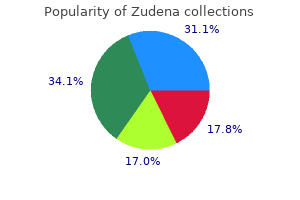
Purchase zudena 100 mg onlineSome o the aponeurotic fbers use with the median band erectile dysfunction middle age generic zudena 100mg on-line, and other fbers arch over it to blend with the aponeurosis arising rom the opposite facet erectile dysfunction homeopathic drugs order genuine zudena on-line. On the radial facet o each digit erectile dysfunction doctor indianapolis buy zudena no prescription, a lumbrical muscle attaches to the radial lateral band erectile dysfunction drugs forum buy zudena with a visa. The visor-like "hood" ormed by the extensor enlargement over the head o the metacarpal, holding the extensor tendon in the middle o the digit, is anchored on all sides to the palmar ligament (a reinorced portion o the brous layer o the joint capsule o the metacarpophalangeal joints). In orming the extensor growth, every extensor digitorum tendon divides into a median band, which passes to the bottom o the middle phalanx, and two lateral bands, which move to the base o the distal phalanx. The tendons o the interosseous and lumbrical muscle tissue o the hand be a part of the lateral bands o the extensor expansion. The retinacular ligament is a fragile brous band that runs rom the proximal phalanx and brous digital sheath obliquely throughout the middle phalanx and two interphalangeal joints. During fexion o the distal interphalangeal joint, the retinacular ligament becomes taut and pulls the proximal joint into fexion. Similarly, on extending the proximal joint, the distal joint is pulled by the retinacular ligament into practically complete extension. The extensor digitorum acts primarily to extend the proximal phalanges, and thru its collateral reinorcements, it secondarily extends the center and distal phalanges as well. Ater exerting its traction on the digits, or within the presence o resistance to digital extension, it helps extend the hand at the wrist joint. To test the extensor digitorum, the orearm is pronated and the ngers are prolonged. The particular person attempts to keep the digits extended on the metacarpophalangeal joints because the examiner exerts strain on the proximal phalanges by attempting to fex them. I acting normally, the extensor digitorum may be palpated within the orearm, and its tendons can be seen and palpated on the dorsum o the hand. The tendon o this extensor o the little nger runs by way of a separate compartment o the extensor retinaculum, posterior to the distal radio-ulnar joint, throughout the tendinous sheath o the extensor digiti minimi. The tendon then divides into two slips; the lateral one is joined to the tendon o the extensor digitorum, with all three tendons attaching to the dorsal digital enlargement o the little nger. Ater exerting its traction primarily on the 5th digit, it contributes to extension o the hand. To check the extensor digiti minimi, the little nger is extended in opposition to resistance whereas holding digits 2�4 fexed at the metacarpophalangeal joints. Distally, its tendon runs in a groove between the ulnar head and its styloid process, via a separate compartment o the extensor retinaculum inside the tendinous sheath o the extensor carpi ulnaris. To test the extensor carpi ulnaris, the orearm is pronated and the ngers are extended. I appearing normally, the muscle may be seen and palpated in the proximal part o the orearm and its tendon can be elt proximal to the pinnacle o the ulna. The supinator lies deep within the cubital ossa and, along with the brachialis, orms its foor. Spiraling medially and distally rom its steady, osseobrous origin, this sheet-like muscle envelops the neck and proximal part o the shat o the radius. The deep branch o the radial nerve passes between its muscle bers, separating them into supercial and deep elements, because it passes rom the cubital ossa to the posterior part o the arm. As it exits the muscle and joins the posterior interosseous artery, it might be reerred to as the posterior interosseous nerve. The supinator is the prime mover or slow, unopposed supination, especially when the orearm is extended. The biceps brachii additionally supinates the orearm and is the prime mover throughout rapid and orceul supination in opposition to resistance when the orearm is fexed. In the cubital ossa, lateral to the brachialis, the radial nerve divides into deep (motor) and superfcial (sensory) branches. The deep department penetrates the supinator muscle and emerges in the posterior compartment o the orearm as the posterior interosseous nerve.
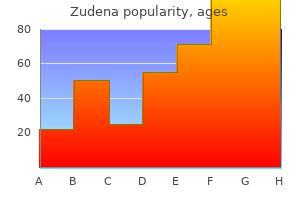
Cheap zudena american expressIn mixture erectile dysfunction by age order zudena 100 mg mastercard, the discs account or 20�25% o the length (height) o the vertebral column erectile dysfunction drugs nhs cheap zudena. As well as allowing movement between adjoining vertebrae erectile dysfunction medication purchase zudena 100 mg with visa, their resilient deormability permits them to function shock absorbers erectile dysfunction causes treatment discount zudena 100mg without a prescription. The anuli insert into the graceful, rounded epiphysial rims on the articular suraces o the vertebral our bodies ormed by the used anular epiphyses. The bers orming every lamella run obliquely rom one vertebra to one other, about 30 or more levels rom vertical. The bers o adjacent lamellae cross each other obliquely in opposite instructions at angles o more than 60�. The anulus becomes decreasingly vascularized centrally, and solely the outer third o the anulus receives sensory innervation. At delivery, these pulpy nuclei are about 88% water and are initially extra cartilaginous than brous. The nuclei turn out to be broader when compressed and thinner when tensed or stretched (as when hanging or suspended). Compression and rigidity happen concurrently in the identical disc throughout anterior and lateral fexion and extension o the vertebral column. During these actions, in addition to throughout rotation, the turgid nucleus acts as a semifuid ulcrum. The superfcial layers o the anulus have been reduce and spread aside to show the course o the fbers. The fbrogelatinous nucleus pulposus occupies the center o the disc and acts as a cushion and shock-absorbing mechanism. The pulpy nucleus attens and the anulus bulges when weight is utilized, as happens during standing and extra so throughout liting. The anulus is simultaneously placed beneath compression on one facet and rigidity on the opposite. The nucleus pulposus is avascular; it receives its nourishment by diusion rom blood vessels on the periphery o the anulus brosus and vertebral body. However, their thickness relative to the scale o the bodies they connect is most clearly associated to the vary o movement, and relative thickness is greatest in the cervical and lumbar regions. The discs are thicker anteriorly in the cervical and lumbar areas, their various shapes producing the secondary curvatures o the vertebral column. Uncovertebral "joints" or clets (o Luschka) generally develop between the unci o the bodies o C3 or C4� C6 or C7 vertebrae and the beveled inerolateral suraces o the vertebral our bodies superior to them ater 10 years o age. The articulating suraces o these joint-like constructions are lined with cartilage moistened by fuid contained inside an interposed potential area, or "capsule. The uncovertebral "joints" are requent websites o bone spur ormation in later years, which can trigger neck pain. These small, synovial joint-like structures are between the unci o the our bodies o the lower vertebrae and the beveled suraces o the vertebral our bodies superior to them. The inerior thoracic (T9�T12) and superior lumbar (L1�L2) vertebrae, with associated discs and ligaments, are proven. The pedicles o the T9�T11 vertebrae have been sawn by way of and their bodies and intervening discs removed to provide an anterior view o the posterior wall o the vertebral canal. This ligament prevents hyperextension o the vertebral column, maintaining stability o the joints between the vertebral our bodies. The posterior longitudinal ligament is a much narrower, somewhat weaker band than the anterior longitudinal ligament. The posterior longitudinal ligament runs inside the vertebral canal along the posterior side o the vertebral our bodies. This ligament weakly resists hyperfexion o the vertebral column and helps prevent or redirect posterior herniation o the nucleus pulposus. The joint capsule is attached to the margins o the articular suraces o the articular processes o adjacent vertebrae. Accessory ligaments unite the laminae, transverse processes, and spinous processes and assist stabilize the joints. The zygapophysial joints allow gliding movements between the articular processes; the form and disposition o the articular suraces decide the kinds o movement potential. The zygapophysial joints are innervated by articular branches that come up rom the medial branches o the posterior rami o spinal nerves.
Extract of Juniper (Juniper). Zudena. - Is Juniper effective?
- Are there any interactions with medications?
- Upset stomach, heartburn, bloating, loss of appetite, urinary tract infections (UTIs), kidney and bladder stones, joint and muscle pain, wounds, and other conditions.
- What is Juniper?
- How does Juniper work?
- Dosing considerations for Juniper.
- Are there safety concerns?
Source: http://www.rxlist.com/script/main/art.asp?articlekey=96708
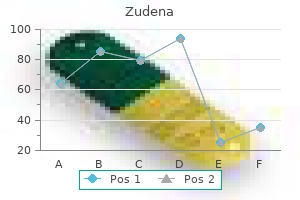
Order zudena 100 mg otcParasympathetic and visceral aerent reex fbers traverse pelvic plexuses and pelvic splanchnic nerves impotence due to diabetes purchase zudena 100 mg with amex. Uterus: Shaped like an inverted pear erectile dysfunction treatment spray buy zudena now, the uterus is the organ by which the blastocyst (early embryo) implants and develops right into a mature embryo and then a etus erectile dysfunction 34 purchase zudena 100 mg line. The uterus is often anteverted and anteexed in order that its weight is borne largely by the urinary bladder erectile dysfunction juice drink buy generic zudena on line, though it also receives signifcant passive help rom the cardinal ligaments and lively support rom the muscle tissue o the pelvic oor. The vagina lies between and is intently related to the urethra anteriorly and rectum posteriorly but is separated rom the latter by the peritoneal recto-uterine pouch superiorly and the ascial rectovaginal septum ineriorly. The vagina is indented (invaginated) anterosuperiorly by the uterine cervix in order that an encircling pocket or vaginal ornix is ormed around it. Most o the vagina is situated within the pelvis, receiving blood by way of pelvic branches o the inner iliac arteries (uterine and vaginal arteries) and draining immediately into the uterovaginal venous plexus and, via deep (pelvic) routes, to the interior and external iliac and sacral lymph nodes. The ineriormost part o the vagina is positioned throughout the perineum, receiving blood rom the inner pudendal artery and draining via superfcial (perineal) routes into superfcial inguinal nodes. The vagina is succesful o remarkable distension, enabling handbook examination (palpation) o pelvic landmarks and viscera (especially the ovaries) in addition to o pathology. Innervation o uterus and vagina: the ineriormost (perineal) portion o the vagina receives somatic innervation by way of the pudendal nerve (S2�S4) and is, thereore, sensitive to touch and temperature. The remainder o the vagina and uterus is pelvic and thus visceral in its location, receiving innervation rom autonomic and visceral aerent fbers. All unconscious, reex-type sensation travels retrogradely along the parasympathetic pathways to the S2�S4 spinal sensory ganglia, as does ache sensation arising in the subperitoneal uterus (primarily cervix) and vagina (inerior to the pelvic pain line)-that is, rom the start canal. However, ache sensation rom the intraperitoneal uterus (superior to the pelvic ache line) travels retrogradely alongside the sympathetic pathway to the ineriormost thoracic and superior lumbar spinal ganglia. Epidural anesthesia may be administered to take benefit o the discrepancy within the pain pathways to acilitate participatory childbirth strategies; uterine contractions are elt, however the birth canal is anesthetized. From both external and inner iliac nodes, lymph fows through common iliac and lumbar (caval/aortic) lymph nodes, draining by way of lumbar lymphatic trunks into the cisterna chyli. Lymphatic vessels rom the superolateral features o the bladder move to the exterior iliac lymph nodes, whereas those rom the undus and neck move to the inner iliac lymph nodes. Some vessels rom the neck o the bladder drain into the sacral or frequent iliac lymph nodes. Most lymphatic vessels rom the emale urethra and proximal half o the male urethra pass to the inner iliac lymph node. However, a ew vessels rom the emale urethra may also drain into the sacral nodes and, rom the distal emale urethra, to the inguinal lymph nodes. Lymphatic vessels rom the inerior hal o the rectum drain on to sacral lymph nodes or, especially rom the distal ampulla, ollow the center rectal vessels to drain into the interior iliac lymph nodes. Lymphatic vessels rom the ductus deerens, ejaculatory ducts, and inerior parts o the seminal glands drain to the external iliac lymph nodes. The lymphatic vessels rom the superior parts o the seminal glands and prostate terminate chiefy within the internal iliac lymph nodes, however some drainage rom the latter could cross to the sacral nodes. In the anatomical position, the surace o the perineum-the perineal region-is the narrow area between the proximal parts o the thighs. The osseobrous constructions marking the boundaries o the perineum (perineal compartment). A transverse line becoming a member of the anterior ends o the ischial tuberosities divides the diamond-shaped perineum into two triangles, the oblique planes o which intersect on the transverse line. The anal triangle lies posterior Lymphatic vessels rom the ovaries, joined by vessels rom the uterine tubes and most rom the undus o the uterus, ollow the ovarian veins as they ascend to the proper and let lumbar (caval/aortic) lymph nodes. Lymphatic vessels rom the uterus drain in plenty of directions, coursing alongside the blood vessels that provide it in addition to the ligaments connected to it: Most lymphatic vessels rom the undus and superior uterine physique cross alongside the ovarian vessels to the lumbar (caval/aortic) lymph nodes, but some vessels rom the undus, particularly those close to the entrance o the uterine tubes and attachments o the round ligaments, run alongside the round ligament o the uterus to the supercial inguinal lymph nodes. Vessels rom most o the uterine physique and a few rom the cervix cross throughout the broad ligament to the external iliac lymph nodes. Vessels rom the uterine cervix also pass along the uterine vessels, throughout the transverse cervical ligaments, to the inner iliac lymph nodes, and along uterosacral (sacrogenital) ligaments to the sacral lymph nodes.
100 mg zudena amexAs the ovarian artery enters the lesser pelvis erectile dysfunction clinics 100 mg zudena with amex, it crosses the origin o the external iliac vessels erectile dysfunction heart attack buy cheap zudena 100mg. This vessel descends in or close to the midline anterior to the bodies o the final one or two lumbar vertebrae and the sacrum and coccyx impotence vacuum pumps purchase zudena australia. During pelvic laparoscopic procedures erectile dysfunction doctors austin texas order zudena with paypal, it supplies a useul indication o the midline on the posterior wall o the pelvis. Beore the median sacral artery enters the lesser pelvis, it typically provides rise to a pair o L5 arteries. As it descends over the sacrum, the median sacral artery offers o small parietal (lateral sacral) branches that anastomose with the lateral sacral arteries. It also offers rise to small visceral branches to the posterior half o the rectum, which anastomose with the superior and center rectal arteries. The median sacral artery represents the caudal finish o the embryonic dorsal aorta, which gotten smaller as the tail-like caudal eminence o the embryo disappeared. They anastomose with the interior vertebral venous plexus (Chapter 2), offering an alternate collateral pathway to attain either the inerior or superior vena cava. It can also provide a pathway or metastasis o prostatic or ovarian most cancers cells to vertebral or cranial sites. Lymph Nodes o Pelvis the lymph nodes receiving lymph drainage rom pelvic organs are variable in quantity, size, and location. They receive lymph mainly rom the inguinal lymph nodes; nonetheless, they obtain lymph rom pelvic viscera, particularly the superior parts o the center to anterior pelvic organs. Internal iliac lymph nodes: clustered around the anterior and posterior divisions o the internal iliac artery and the origins o the gluteal arteries. They receive drainage rom the inerior pelvic viscera, deep perineum, and gluteal region and drain into the frequent iliac nodes. Sacral lymph nodes: lie in the concavity o the sacrum, adjoining to the median sacral vessels. They receive lymph rom postero-inerior pelvic viscera and drain either to inside or common iliac nodes. These nodes begin a standard route or drainage rom the pelvis that passes subsequent to the lumbar (caval/aortic) nodes. Inconstant direct drainage to the frequent iliac nodes happens rom some pelvic organs. Both major and minor teams o pelvic nodes are extremely interconnected, in order that many nodes could be removed with out disturbing drainage. While the lymphatic drainage tends to parallel the venous drainage (except or that to the external iliac nodes, the superior rectal artery is the direct continuation o the inerior mesenteric artery. It crosses the let common iliac vessels and descends within the sigmoid mesocolon to the lesser pelvis. At the level o the S3 vertebra, the superior rectal artery divides into two branches, which descend on all sides o the rectum and provide it as ar ineriorly as the inner anal sphincter. Pelvic Veins Pelvic venous plexuses are ormed by the interjoining veins surrounding the pelvic viscera. The varied plexuses within the lesser pelvis (rectal, vesical, prostatic, uterine, and vaginal) unite and are drained mainly by tributaries o the interior iliac veins, however some o them drain via the superior rectal vein into the inerior mesenteric vein o the hepatic portal system. Additional relatively minor paths o venous drainage rom the lesser pelvis include the parietal median sacral vein and, in emales, the ovarian veins. The internal iliac veins orm superior to the larger sciatic oramen and lie postero-inerior to the interior iliac arteries. Tributaries o the inner iliac veins are more variable than the branches o the inner iliac artery with which they share names, however roughly accompany them, draining the same territories that the arteries provide. The internal iliac veins merge with the external iliac veins to orm the frequent iliac veins, which unite at the level o vertebra L4 or L5 to orm the inerior vena cava. The emale (right) and male (left) patterns o the systemic (vena caval) system and the hepatic portal venous system o the abdominopelvic cavity are proven. Venous drainage rom pelvic organs ows mainly to the caval system by way of the interior iliac veins.
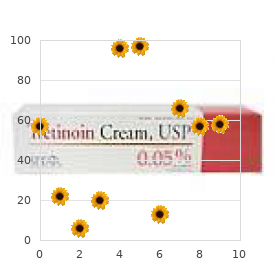
Generic 100mg zudena otcExtension o the vertebral column is most marked within the lumbar area and is often extra in depth than fexion impotence after robotic prostatectomy buy zudena from india. Lateral fexion o the vertebral column is biggest in the cervical and lumbar areas erectile dysfunction testosterone injections order zudena with a visa. Relative stability can be conerred on this part o the vertebral column through its connection to the sternum by the ribs and costal cartilages erectile dysfunction remedies generic zudena 100 mg otc. This rotation o the higher trunk zinc erectile dysfunction treatment order cheap zudena on line, in combination with the rotation permitted within the cervical region and that on the atlantoaxial joints, permits torsion o the axial skeleton that happens as one appears back over the shoulder. Curvatures o Vertebral Column the vertebral column in adults has our curvatures that occur in the cervical, thoracic, lumbar, and sacral areas. The thoracic and sacral kyphoses (singular = kyphosis) are concave anteriorly, whereas the cervical and lumbar lordoses (singular = lordosis) are concave posteriorly. When the posterior surace o the trunk is observed, especially in a lateral view, the traditional curvatures o the vertebral column are particularly obvious. The thoracic and sacral kyphoses are primary curvatures that develop through the etal period in relationship to the (fexed) etal place (Moore et al. The primary curvatures are retained all through lie as a outcome of o dierences in top between the anterior and posterior parts o the vertebrae. The our curvatures o the grownup vertebral column-cervical, thoracic, lumbar, and sacral- are contrasted with the C-shaped curvature o the column during etal lie, when solely the first (1�) curvatures exist. The cervical and lumbar lordoses are secondary curvatures that result rom extension rom the fexed etal position. The cervical lordosis becomes ully evident when an inant begins to raise (extend) the head while susceptible and to maintain the top erect whereas sitting. This curvature, typically extra pronounced in emales, ends at the lumbosacral angle ormed on the junction o L5 vertebra with the sacrum. The sacral kyphosis additionally diers in males and emales, with that o the emale decreased in order that the coccyx protrudes much less into the pelvic outlet (see Chapter 6, Pelvis and Perineum). The muscle tissue that provide resistance to the increase in curvature oten ache when the load is borne or extended intervals. When sitting, particularly in the absence o again assist or long intervals, one usually "cycles" between again fexion (slumping) and extension (sitting up straight) to decrease stiness and atigue. This permits alternation between the lively assist offered by the extensor muscles o the back and the passive resistance to fexion supplied by ligaments. Parent arteries o periosteal, equatorial, and spinal branches happen at all levels o the vertebral column, in close affiliation with it, and include the ollowing arteries (described intimately in different chapters): Vertebral and ascending cervical arteries within the neck (Chapter 9, Neck). The main segmental arteries o the trunk: Posterior intercostal arteries within the thoracic region (Chapter 2, Back). Periosteal and equatorial branches come up rom these arteries as they cross the exterior (anterolateral) suraces o the vertebrae. Smaller anterior and posterior vertebral canal branches cross to the vertebral body and vertebral arch, respectively, and provides rise to ascending and descending branches that anastomose with the spinal canal branches o adjacent levels. Anterior vertebral canal branches ship nutrient arteries anteriorly into the vertebral bodies that offer most o the red marrow o the central vertebral body (Bogduk, 2012). The larger branches o the spinal branches continue as terminal radicular or segmental medullary arteries distributed to the posterior and anterior roots o the spinal nerves and their coverings and to the spinal wire, respectively (see "Vasculature o Spinal Cord and Spinal Nerve Roots" in this chapter). In the thoracic and lumbar areas, each vertebra is encircled on three sides by paired intercostal or lumbar arteries that come up rom the aorta. The segmental arteries provide equatorial branches to the vertebral body, and posterior branches provide the vertebral arch constructions and the back muscular tissues. Spinal veins orm venous plexuses along the vertebral column, both inside and out of doors the vertebral canal. These plexuses are the interior vertebral venous plexuses (epidural venous plexuses) and external vertebral venous plexuses, respectively. The venous drainage parallels the arterial supply and enters the external and internal vertebral venous plexuses. There is also anterolateral drainage rom the external elements o the vertebrae into segmental veins. The dense plexus o thin-walled vessels within the vertebral canal, the internal vertebral venous plexuses, consists o valveless anastomoses between anterior and posterior longitudinal venous sinuses.

Cheap zudena 100 mg onlineThe rectum begins on the rectosigmoid junction as the teniae o the sigmoid colon spread and unite into a continuous longitudinal layer o smooth muscle and the omental appendices stop erectile dysfunction caused by guilt discount zudena 100mg free shipping. The rectum ends with the anorectal exure as the gut penetrates the pelvic diaphragm erectile dysfunction treatment blog purchase zudena line, turning into the anal canal erectile dysfunction doctor delhi purchase generic zudena on-line. Despite the Latin time period rectus (straight) erectile dysfunction caused by hemorrhoids discount zudena 100mg without a prescription, the rectum is concave anteriorly because the sacral exure and has three lateral exures ormed in relation to the internal transverse rectal olds. The superior, center, and inerior parts o the rectum are, respectively, intraperitoneal, retroperitoneal, and subperitoneal. Collateral arterial circulation and a portocaval venous anastomosis outcome rom anastomoses o the superior and middle rectal vessels. Sympathetic nerve fbers move to the rectum (especially blood vessels and inside anal sphincter) rom lumbar spinal wire segments via the hypogastric/pelvic plexuses and the peri-arterial plexus o the superior rectal artery. Parasympathetic and visceral aerent fbers involve the center sacral spinal wire segments and spinal ganglia. Male Internal Genital Organs the male inner genital organs embrace the testes, epididymides (singular = epididymis), ductus deerentes (singular = ductus deerens), seminal glands, ejaculatory ducts, prostate, and bulbo-urethral glands. The testes and epididymides (described in Chapter 5, Abdomen) are considered inner genital organs on the basis o their developmental position and homology with the inner emale ovaries. The genital organs are demonstrated: testis, epididymis, ductus deerens, ejaculatory duct, and penis, with the accessory glandular structures (seminal gland, prostate, and bulbo-urethral gland). The spermatic twine connects the testis to the stomach cavity, and the testis lies externally in a musculocutaneous pouch, the scrotum. The ductus deerens has relatively thick muscular partitions and a minute lumen, giving it a cord-like rmness. During the pelvic part o its course, the ductus deerens maintains direct contact with the peritoneum; no different construction intervenes between them. The ductus crosses superior to the ureter near the posterolateral angle o the urinary bladder, running between the ureter and the peritoneum o the ureteric old to attain the undus o the bladder. The relationship o the ductus deerens to the ureter in the male is comparable, though o lesser medical significance, to that o the uterine artery to the ureter in the emale. Posterior to the bladder, the ductus deerens Left suprarenal gland at rst lies superior to the seminal gland after which descends medial to the ureter and the gland. Here, the ductus deerens enlarges to orm the ampulla o the ductus deerens beore its termination. The tiny artery to the ductus deerens usually arises rom a superior (sometimes inerior) vesical artery. Veins rom most o the ductus drain into the testicular vein, including the distal pampiniorm plexus. They secrete a thick alkaline fuid with ructose (an energy source or sperms) and a coagulating agent that mixes with the sperms as they move into the ejaculatory ducts and urethra. The superior ends o the seminal glands are coated with peritoneum and lie posterior to the ureters, where the peritoneum o the rectovesical pouch separates them rom the rectum. The inerior ends o the seminal glands are intently related to the rectum and are separated rom it solely by the rectovesical septum. The duct o the seminal gland joins the ductus deerens to orm the ejaculatory duct. The arteries to the seminal glands derive rom the inerior vesical and center rectal arteries. During growth, because the testis descends ineriorly and laterally rom its unique place (medial to the location o the kidneys on the posterior stomach wall) to and then through the inguinal canal, the ureter is crossed by testicular vessels in the stomach and by the ductus deerens within the pelvis. The ejaculatory ducts are slender tubes that come up by the union o the ducts o the seminal glands with the ductus deerentes. The ejaculatory ducts converge and open on the seminal colliculus by tiny, slit-like apertures on, or just inside, the opening o the prostatic utricle. The arteries to the ductus deerens, usually branches o the superior (but requently inerior) vesical arteries, provide the ejaculatory ducts. The umbilical ligaments, like the urinary bladder, are embedded in extraperitoneal or subperitoneal ascia (mostly eliminated in this dissection).
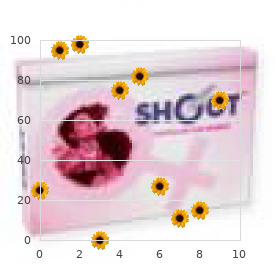
100mg zudena free shippingThe cervix o the uterus is the cylindrical outcome erectile dysfunction without treatment purchase 100mg zudena with visa, relatively narrow inerior third o the uterus impotence lack of sleep 100mg zudena free shipping, roughly 2 erectile dysfunction aafp cheap 100mg zudena free shipping. The rounded vaginal half surrounds the exterior os o the uterus and is surrounded in turn by a slender recess new erectile dysfunction drugs 2012 buy cheap zudena 100mg line, the vaginal ornix. The supravaginal half is separated rom the bladder anteriorly by free connective tissue and rom the rectum posteriorly by the recto-uterine pouch. The slit-like uterine cavity is roughly 6 cm in length rom the exterior os to the wall o the undus. This usiorm canal extends rom a narrowing contained in the isthmus o the uterine body, the anatomical inner os, through the supravaginal and vaginal components o the cervix, speaking with the lumen o the vagina via the exterior os. The uterine cavity (in explicit, the cervical canal) and the lumen o the vagina collectively constitute the start canal, via which the etus passes at the end o gestation. In addition to autonomic (visceral motor) fbers, these nerves convey visceral aerent fbers rom these organs. Perimetrium-the serosa or outer serous layer-consists o peritoneum supported by a skinny layer o connective tissue. Myometrium-the center layer o clean muscle- becomes significantly distended (more extensive however much thinner) during pregnancy. The major branches o the blood vessels and nerves o the uterus are positioned on this layer. During childbirth, contraction o the myometrium is hormonally stimulated at intervals o reducing size to dilate the cervical os and expel the etus and placenta. The endometrium is actively concerned within the menstrual cycle, diering in construction with each stage o the cycle. The amount o muscular tissue within the cervix is markedly lower than in the body o the uterus. The cervix is mostly brous and is composed mainly o collagen with a small amount o easy muscle and elastin. Externally, the ligament o the ovary attaches to the uterus postero-inerior to the uterotubal junction. These two ligaments are vestiges o the ovarian gubernaculum, associated to the relocation o the gonad rom its developmental position on the posterior belly wall. The broad ligament o the uterus is a double layer o peritoneum (mesentery) that extends rom the edges o the uterus to the lateral partitions and foor o the pelvis. The two layers o the broad ligament are steady with one another at a ree edge that surrounds the uterine tube. Laterally, the peritoneum o the broad ligament is extended superiorly over the vessels because the suspensory ligament o the ovary. Between the layers o the broad ligament on all sides o the uterus, the ligament o the ovary lies posterosuperiorly and the round ligament o the uterus lies antero-ineriorly. The uterine tube lies within the anterosuperior ree border o the broad ligament, inside a small mesentery known as the mesosalpinx. Similarly, the ovary lies within a small mesentery known as the mesovarium on the posterior aspect o the broad ligament. The largest half o the broad ligament, inerior to the mesosalpinx and mesovarium, which serves as a mesentery or the uterus itsel, is the mesometrium. The principal helps o the uterus holding it in this position are both passive and active or dynamic. Its tone during sitting and standing and energetic contraction in periods o elevated intra-abdominal strain (sneezing, coughing, and so forth. Passive support o the uterus is supplied by its position-the way during which the normally anteverted and antefexed uterus rests on top o the bladder. The cervix is the least cellular part o the uterus as a end result of o the passive help supplied by hooked up condensations o endopelvic ascia (ligaments), which may also contain clean muscle. Together, these passive and lively helps keep the uterus centered within the pelvic cavity and resist the tendency or the uterus to all or be pushed through the vagina (see the Clinical Box "Disposition o Uterus").
|



